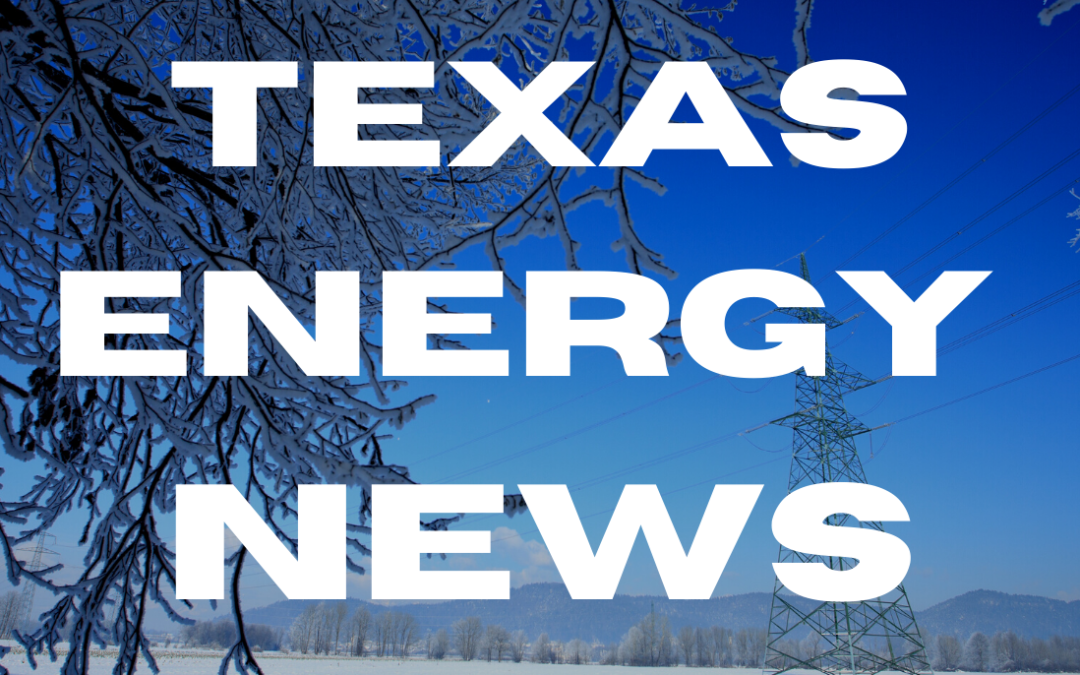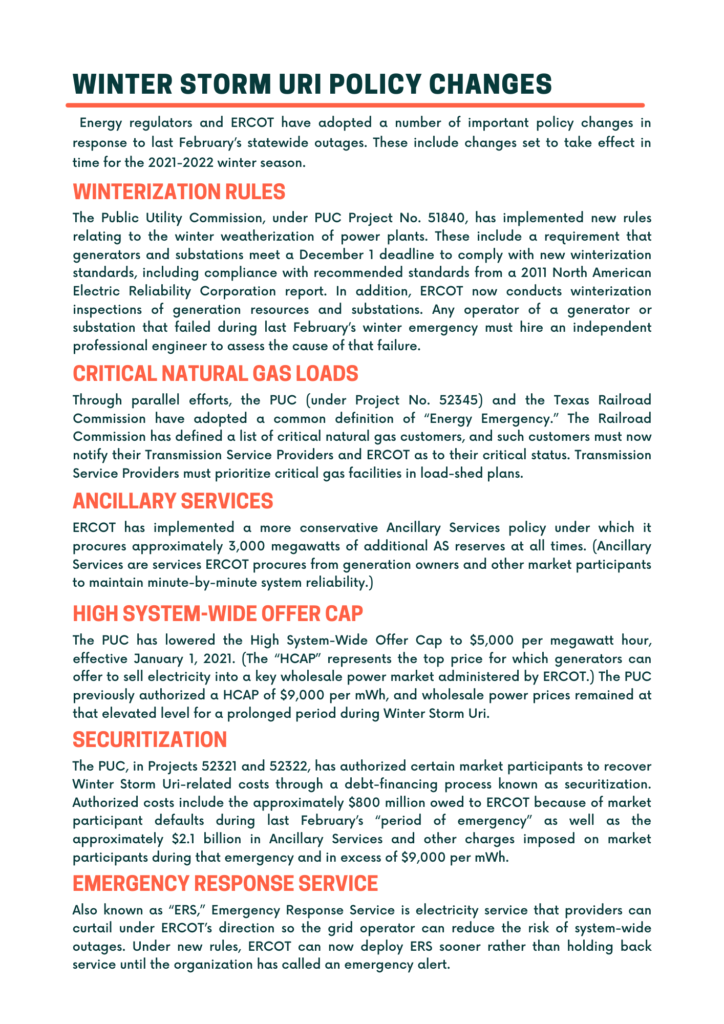A list of some of the most important of these post-Winter Storm Uri reforms, including those set to take effect in time for this year’s winter season.
________________________________________________
In response to the political upheaval following February’s devastating power outages, both Gov. Greg Abbott and PUC chair Peter Lake have boldly promised that the lights will stay on this winter — come what may.
But while probability calculations and politics almost certainly underlie such bold proclamations (most experts would agree that one can never definitively rule out all outage possibilities), it is nonetheless indisputably true that regulators and ERCOT have enacted a number of meaningful reforms in recent months.
Just below we have listed by category some of the most important of these post-Winter Storm Uri reforms, including those set to take effect in time for the 2021-2022 winter season. We also have enumerated other potential changes that remain under consideration by regulators.
ANCILLARY SERVICES: The Electric Reliability Council of Texas, the organization that manages the state’s primary power grid, has implemented a more conservative Ancillary Services policy. Under this new policy, ERCOT now procures approximately 3,000 megawatts of additional Ancillary Services reserves at all times. (Ancillary Services are services provided from generation owners and other market players that ERCOT procures to maintain minute-by-minute reliability.)
WEATHERIZATION RULES: The Public Utility Commission, under PUC Project No. 51840, has implemented new rules relating to the weatherization of power plants. These new rules include a requirement that generators and substations by December 1 comply with new weatherization standards, including compliance with recommendations included in a 2011 North American Electric Reliability Corporation report. (You can see the report, here). Moreover, ERCOT now is conducting inspections of generation resources and substations to ensure compliance with the new standards. Any operator of a generator or substation that suffered a weather-related failure during Winter Storm Uri must hire an independent professional engineer to assess the cause of that failure.
CRITICAL NATURAL GAS LOADS: The PUC (under Project No. 52345) and the Texas Railroad Commission have conducted parallel rulemaking efforts relating to the identification of “critical load” natural gas facilities (such as wells, gas-processing plants and pipelines). The rules are important because experts have identified failures by the gas industry as major contributing factors to last February’s winter emergency. These new rules should give electric utilities more visibility regarding which gas facilities play critical roles for grid reliability, and this, in turn, will allow electric utilities to make better decisions regarding which gas facilities they should prioritize for service during emergencies. Through parallel efforts, the PUC and Railroad Commission have adopted a common definition of “Energy Emergency.” The Railroad Commission also has defined a list of critical natural gas customers. Critical gas customers also now are required to notify their Transmission Service Providers and ERCOT at to their critical status. New rules also require Transmission Service Providers to prioritize critical gas facilities in their load-shed plans.
HIGH SYSTEM-WIDE OFFER CAP: The PUC has set the High System-Wide Offer Cap to $5,000 per megawatt hour, beginning January 1, 2021. The “HCAP” represents the top price for which generators can offer to sell electricity into a key wholesale power market administered by ERCOT. The HCAP previously was set at $9,000 per mWh, and wholesale power prices remained at that elevated level for a prolonged period during Winter Storm Uri. Such wholesale power during more typically conditions sells for less than $50 per mWh.
SECURITIZATION: The PUC, in Dockets 52321 and 52322, has authorized certain market participants to recover Winter Storm Uri-related costs through a debt-financing process known as securitization. The authorized costs eligible for recovery include “default” balances, which statute defines as approximately $800 million owed to ERCOT because of market participant defaults during the Winter Storm Uri “period of emergency.” Authorized costs also include “uplift” balances, which consist of approximately $2.1 billion in Ancillary Services and other charges imposed on market participants during Winter Storm Uri in excess of $9,000 per mWh. (You can read more about the Securitization, as well as uplift and default balances, here.)
EMERGENCY RESPONSE SERVICE: Also known as “ERS,” Emergency Response Service is electricity service that providers can curtail under ERCOT’s direction in order to reduce the risk of system-wide outages. Providers of ERS receive payment in exchange for being available to ERCOT for curtailment. Under new rules, ERCOT can now deploy ERS sooner — as scarcity approaches and in order to prevent scarcity from occurring — rather than holding the service back until ERCOT has called an emergency alert. ERCOT also has adopted other operational changes related to ERS.
POLICIES AWAITING IMPLEMENTATION: The PUC has agreed that ERCOT should continue development of new categories of Ancillary Services known as “Fast Frequency Response,” “ERCOT Contingency Reserve Service” and “Voltage Support.” Fast Frequency Response will not come online prior to May 2022; and ERCOT Contingency Reserve Service will not see deployment before the first half of 2023. Voltage Support remains in development.
POLICIES UNDER CONSIDERATION: The PUC is working to implement rules that will require all relevant market entities to file with the commission “Emergency Operations Plans.” That ongoing rulemaking is under Docket 51841. The Railroad Commission is working to implement new rules relating to gas curtailments by gas suppliers. Stakeholder comments in that rulemaking are due by January 7. Those proposed rules can be found on the RRC website at https://www.rrc.texas.gov/general-counsel/rules/proposed-rules/ under the “Chapter 7. Gas Services” section.


